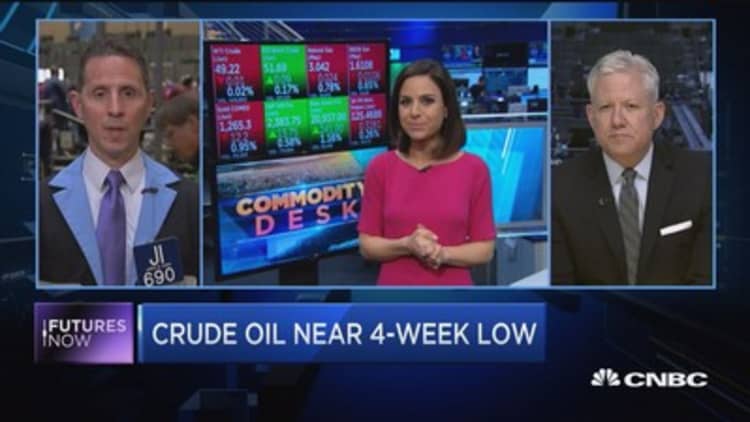
Oil prices edged up in choppy trade on Tuesday as U.S. crude inventory data that was forecast to show a drawdown faced doubts about OPEC's ability to reduce a global glut.
Brent crude was up 55 cents at $52.15 a barrel by 2:34 p.m. ET (1834 GMT), after touching a four-week low of $51.30.
Meanwhile, U.S. crude futures settled 33 cents higher at $49.56 a barrel. At its lowest point of the day, the contract fell to $48.87, roughly in line with its 200-day moving average of $48.91.
Analysts polled ahead of inventory reports from the industry group American Petroleum Institute (API) and the U.S. Department of Energy's Energy Information Administration (EIA) estimated, on average, that U.S. crude stocks fell 1.6 million barrels last week, the third consecutive weekly draw.
The API data is due at 4:30 p.m. ET. The EIA report comes out Wednesday at 10:30 a.m. ET.

Brent is down about 5 percent since early December, when the Organization of the Petroleum Exporting Countries and Russia agreed to cut output by 1.8 million barrels per day (bpd) in the first half of the year.
With oil supplies still around record highs, Stephen Schork of the Schork report said on Tuesday that "OPEC has failed miserably in its endeavour to balance the oil market."
Matt Smith, director of commodity research at ClipperData in Louisville, Kentucky said global crude loadings are at record levels.
"We still see that continue to tick higher," Smith said. "Until we see the loadings drop, until we see the oil on the water falling, we are unlikely to see the market materially moving toward rebalancing."
Russia said on Monday its oil output could climb to the highest rate in 30 years if OPEC and non-OPEC producers do not extend their supply reduction deal beyond June 30.
And on Tuesday, the Interfax news agency quoted Russia's Deputy Prime Minister Arkady Dvokovich as saying Russia may increase oil production if it feels prices are unlikely to fall as a result.
To reduce the supply overhang, JPMorgan said OPEC "will be forced to renew, and possibly deepen the agreement if they wish to keep prices much above $50 per barrel."

But ClipperData's Smith said there was a lot of posturing ahead of the May 25 meeting of OPEC and non-OPEC producers.
"We have a month before the meeting in Vienna," he said, "Between now and then were going to get a lot of contrasting rhetoric."
SEB commodities strategist Bjarne Schieldrop said the current climate will be uncertain until the May 25 meeting. "It doesn't make sense to sell down to $45 ahead of that," he said.
Shieldrop said crude demand could pick up and the long-awaited draw in global inventories could start to show with refinery maintenance around Europe and Russia set to peak in May at an estimated 1.5 million bpd.
However, analysts on Monday told CNBC that lackluster gasoline demand threatens to leave refiners with large fuel stockpiles. That could ultimately dent demand for crude oil later this year and pull prices lower once the summer driving season winds down.
U.S. gasoline futures were down about 0.6 percent, weighing on the energy complex on Tuesday.
— CNBC's Tom DiChristopher contributed to this report.

